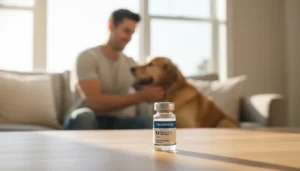How Long Can Tirzepatide Be at Room Temperature? Essential Guidelines for Safe Storage

Introduction
When we think about effective weight loss and diabetes management, the medication tirzepatide often comes to mind. As a member of the glucagon-like peptide-1 (GLP-1) receptor agonists, it is praised for its significant impact on weight loss and blood sugar control. However, did you know that proper storage is crucial to maintain its efficacy? Understanding how long tirzepatide can safely remain at room temperature is essential for anyone using this medication.
With the increasing popularity of tirzepatide, also marketed under the brands Mounjaro and Zepbound, it’s vital to be aware of the specific storage requirements to ensure it remains effective. As a medication that is sensitive to temperature changes, the guidelines for its storage are particularly stringent. In this blog post, we will thoroughly explore how long tirzepatide can be stored outside the refrigerator, the implications of improper storage, and practical tips for ensuring that your medication maintains its potency.
Our goal is to empower you with the knowledge needed to handle tirzepatide safely, whether you're at home or on the go. We’ll cover key aspects, such as optimal storage conditions, what happens when the medication is not stored properly, and tips for traveling with tirzepatide. By the end of this article, you’ll have a comprehensive understanding of how to handle your medication safely to support your health journey.
Let’s dive into the details to ensure that you are well-equipped to manage your tirzepatide effectively.
Understanding Tirzepatide and Its Storage Requirements
What is Tirzepatide?
Tirzepatide is a groundbreaking medication used primarily for managing type 2 diabetes and promoting weight loss. It mimics the action of hormones that regulate insulin and glucose metabolism, making it a powerful tool in the management of these conditions. However, tirzepatide is a delicate biological drug, which means it is sensitive to temperature and light. Proper storage is essential to retain its effectiveness.
Optimal Storage Conditions
To ensure tirzepatide remains effective, it should be stored in a refrigerator between 36°F and 46°F (2°C and 8°C). Keeping it in its original carton protects it from light, which can also degrade the medication.
When you receive your tirzepatide, whether it's in vials, injection pens, or syringes, make it a priority to refrigerate it immediately. Following these guidelines will help preserve its potency and effectiveness.
How Long Can Tirzepatide Be at Room Temperature?
General Guidelines
Tirzepatide can be stored at room temperature for a limited period. Specifically, it can be kept outside the refrigerator for up to 21 days as long as it does not exceed temperatures above 86°F (30°C). This timeframe allows for flexibility in case of travel or temporary situations where refrigeration is unavailable.
Conditions for Safe Storage at Room Temperature
While tirzepatide can be out of the refrigerator for up to 21 days, certain conditions must be met to ensure its safety:
- Temperature Control: Keep tirzepatide away from heat sources. Avoid leaving it in cars or near windows where sunlight can increase the temperature significantly.
- Avoid Freezing: Tirzepatide should never be frozen. If it accidentally freezes, it must be discarded, even if it has thawed completely.
- Light Protection: Like when stored in the fridge, tirzepatide should be protected from direct light exposure to maintain its stability.
What Happens if Tirzepatide Exceeds the Time Limit?
If tirzepatide is left out of the refrigerator for more than 21 days, it is crucial to discard it. The medication’s efficacy may diminish significantly beyond this point. An important takeaway is that once tirzepatide has been stored at room temperature, it should not be returned to the refrigerator.
Implications of Improper Storage
Degradation of Efficacy
When tirzepatide is not stored correctly, it begins to degrade. The molecular structure of tirzepatide is sensitive to environmental factors, and improper storage can lead to reduced potency. This means that using tirzepatide that has been improperly stored could compromise your treatment's effectiveness, impacting blood sugar levels and weight loss progress.
Health Risks
While the immediate effects of using degraded tirzepatide may not be toxic, the medication may not perform as intended. This could lead to suboptimal management of diabetes or weight issues. Therefore, adhering to proper storage guidelines is critical for your health.
Recognizing Expired or Degraded Medication
To ensure you’re using effective tirzepatide, be vigilant for signs of degradation. Tirzepatide should be a clear and colorless liquid. If you notice any discoloration, cloudiness, or visible particles, it’s best to discard the medication and consult your pharmacist.
Practical Tips for Storing Tirzepatide Safely
At Home
- Refrigerate Promptly: As soon as you receive your tirzepatide, store it in the refrigerator.
- Label Dates: If you temporarily remove tirzepatide from the fridge, mark the date on the box or a calendar to keep track of how long it has been out.
- Check Your Refrigerator: Regularly verify that your refrigerator is functioning correctly and maintaining the appropriate temperature.
While Traveling
Travel can present unique challenges for medication storage. Here are some tips to keep tirzepatide safe while on the go:
- Insulated Bags: Use insulated bags or coolers to keep tirzepatide at the proper temperature when traveling.
- Avoid Leaving in Cars: Never leave tirzepatide in a car, as temperatures can rise quickly, compromising the medication.
- Plan Ahead: If you’re planning a trip, consider your storage options in advance to ensure that your tirzepatide remains safe.
Conclusion
Understanding how long tirzepatide can be at room temperature and adhering to proper storage guidelines is vital for anyone using this medication. By keeping tirzepatide refrigerated when possible, and knowing the limits for room temperature storage, you can help ensure that the medication remains effective and safe to use.
As we’ve discussed, proper management of tirzepatide involves not only how you take it but also how you store it. This knowledge empowers you to make informed decisions that will positively impact your health journey.
If you are considering starting tirzepatide or have questions about your current regimen, we recommend taking our free assessment quiz to see if you qualify for our personalized weight loss programs. Together, we can find the best approach tailored to your unique needs.
FAQ
Q1: Can I put tirzepatide back in the refrigerator after keeping it at room temperature?
A1: No, once tirzepatide has been stored at room temperature, it should not be returned to the refrigerator. Discard any unused medication after 21 days at room temperature.
Q2: What should I do if I suspect my tirzepatide has been stored improperly?
A2: If you suspect that your tirzepatide has been exposed to temperatures above 86°F (30°C) or has been out of the fridge for more than 21 days, it’s best to discard it and consult your pharmacist for a replacement.
Q3: Is it safe to travel with tirzepatide?
A3: Yes, but you must take precautions to ensure it remains at the correct temperature. Use insulated bags and avoid leaving it in hot environments.
Q4: How can I tell if tirzepatide has gone bad?
A4: Tirzepatide should be clear and colorless. If you notice any discoloration, cloudiness, or visible particles, do not use it and consult your pharmacist.
Q5: What is the shelf life of tirzepatide when refrigerated?
A5: When stored in the refrigerator, tirzepatide typically remains viable until the expiration date marked on the packaging, which is usually several months to a year after receiving it.
For additional insights, consider exploring our quick-access supplements like GLP-1 Daily Support and Weight Loss Boost to support your weight loss journey. Let’s work together towards achieving your health goals!

Transforming Lives, One Step at a Time
Keep reading
Navigating Your Path to Health: When Should You Increase Tirzepatide Dose?
Wondering when should you increase tirzepatide dose for weight loss? Learn the science behind dose escalation, typical schedules, and how to manage side effects for optimal results. Get personalized, medically supervised care with TrimRx.
Navigating Your Journey: When Should I Up My Dose of Tirzepatide for Optimal Weight Loss?
Wondering ‘when should I up my dose of tirzepatide’? Learn about dose escalation, signs it’s time to adjust, and managing side effects for effective weight loss. Get personalized guidance from TrimRx.
Tirzepatide Dosing: When to Go Up a Dose for Optimal Progress
Wondering when to go up a dose on tirzepatide? Learn the key signs, dosing schedule, and safety tips for optimal weight loss and minimal side effects.



